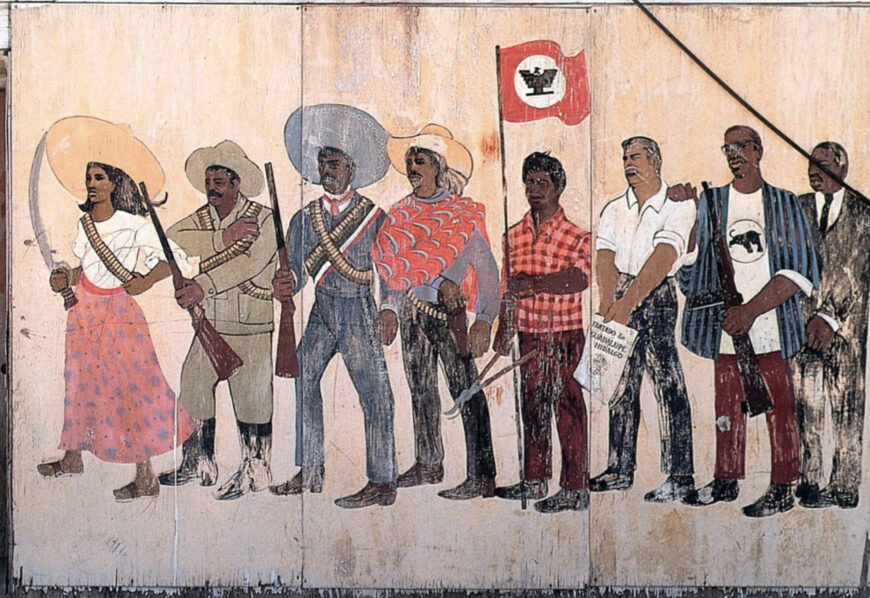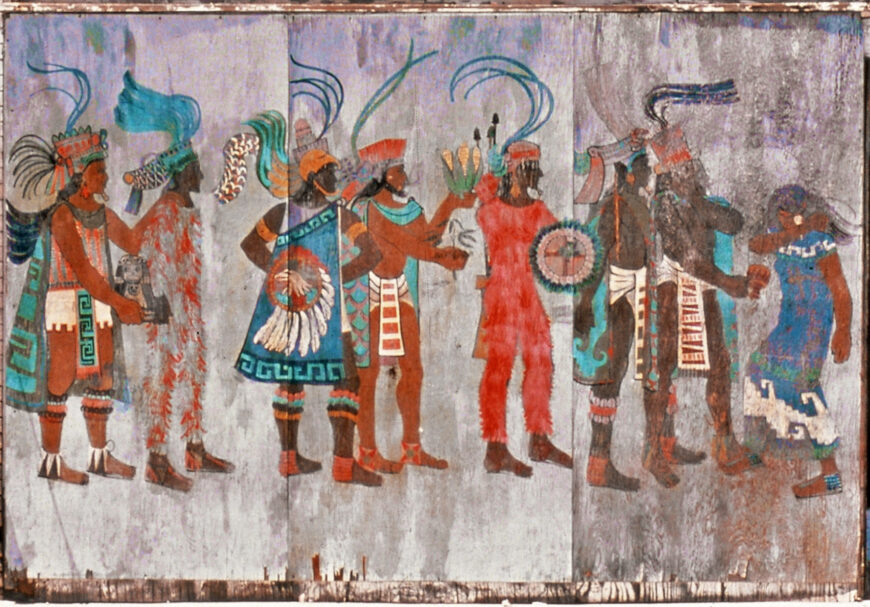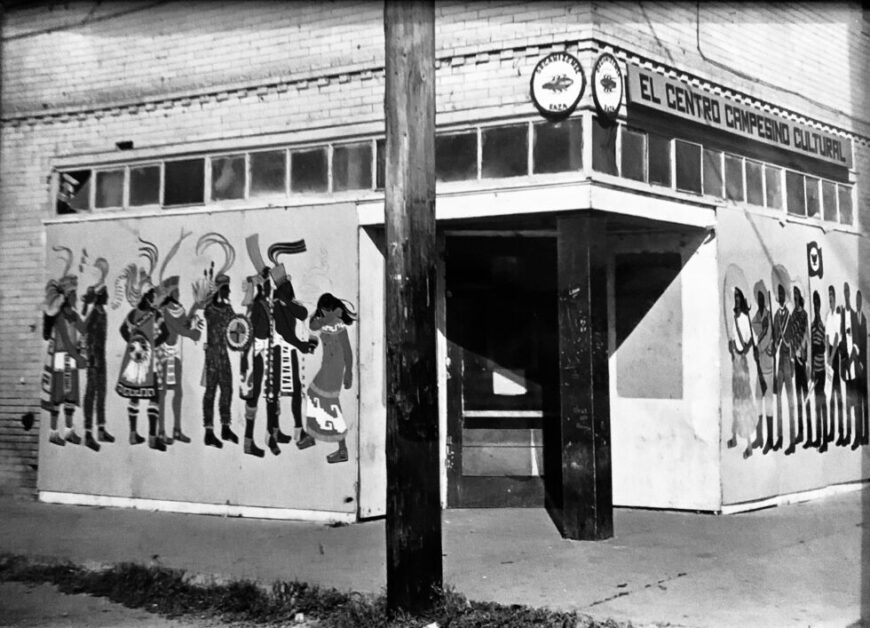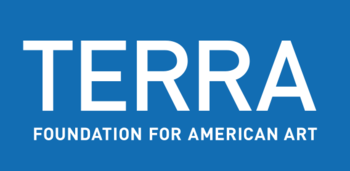Identified as the earliest Chicano mural, Antonio Bernal’s two-panel Del Rey painting encapsulates the goals of the Chicano or Mexican-American civil rights movement of the 1960s and 1970s. Comprised of two painted plywood boards, it represents paired processions of nearly life-size figures, one from ancient Mesoamerica and the other of 19th- and 20th-century revolutionaries. Created for the headquarters of El Teatro Campesino in 1968 in Del Rey, California, the murals originally flanked the building’s main door; they may have also been used as props for theatrical performances. Founded in 1965 by Luis Valdez and Agustín Tira as part of the United Farm Workers, El Teatro Campesino was an important bilingual, activist theater group that promoted Chicana/o civil rights. [1] At some point after their creation, Bernal’s mural disappeared, to be rediscovered in the abandoned former headquarters in 2017.

Antonio Bernal, Del Rey Mural, El Teatro Campesino, Del Rey, California, 1968, paint on plywood (photo: Robert Sommer) © Antonio Bernal
Left panel
On the left we see a parade of Indigenous people, based on the 8th-century Maya murals at Bonampak and other Central Mexican sources. [2] A woman in Aztec-style garments leads, her body seemingly moving as she dances. Facing the seven male figures arrayed behind her, she is about to rotate forward. Her followers appear in colorful ceremonial dress, bearing ritual attributes, such as a bowl from which copal (incense) smoke rises. Several of the men are dressed as elite Aztec (Mexica) warriors, wearing full-length battle suits or Tlahuiztli, as portrayed in the Codex Mendoza, one of them carrying a feather shield, and another with an eagle warrior cape. The figure in the middle of the line-up holds aloft two plants, three ears of maize, the most important crop in ancient Mesoamerica and symbolic of Mexican identity, and a marijuana plant, a humorous and subversive detail added by the artist. The final figure presents a small sculpture of Cihuateotl, based on a work housed in Mexico City’s Museo de Antropología. The image represents the Cihuateteo (plural) from the Aztec underworld, the spirits of women who perished in childbirth, likened to male warriors killed on the battlefield. [3] The amalgamation of costumes and attributes gives visual form to the concept of pan-Indigeneity, proclaims the importance of ancient Mexican history, and asserts the centrality of Indigenous identity to the Chicano civil rights movement.

Antonio Bernal, Del Rey Mural, El Teatro Campesino, Del Rey, California, 1968, paint on plywood (photo: Robert Sommer) © Antonio Bernal
Right panel
The right panel depicts a group of 19th- and 20th-century revolutionaries, joined together in alliance. They are led by an Adelita (a woman fighter from the Mexican Revolution), Pancho Villa (leader of the northern forces in the Revolution), Emiliano Zapata (Indigenous leader from the South), Joaquín Murrieta (a legendary Robin Hood figure from the Gold Rush era who stole from white settlers to give to Mexicans in what is now the U.S.), César E. Chávez (activist, organizer, and founder, along with Dolores Huerta, of the United Farm Workers), Reies López Tijerina (leader of the New Mexico land rights movement, holding a copy of the 1848 Treaty of Guadalupe Hidalgo in his hands), and Malcolm X and Martin Luther King Jr. (Black civil rights leaders). [4] Compared to the historical (yet anonymous) Indigenous figures on the left, the Revolutionaries on the right are less colorful and the composition demonstrates less movement and energy. Whereas the Indigenous figures bear various ritual attributes, these figures on the right are armed, furthering their sense of resolve. The first four historical figures all wear headdresses whereas the 20th-century characters are clothed in attire typical of their era. The figure of César E. Chávez occupies a central position, bearing the red, white, and black flag of the United Farm Workers, with its recognizable eagle form. In his other hand, he holds the short-handled hoe (el cortito), used by the farm workers. This hoe, which required workers to stoop over as they labored, causing debilitating back pain, was eventually banned in California in 1975 thanks to the union’s efforts.

Antonio Bernal, Del Rey Mural, El Teatro Campesino, Del Rey, California, 1968, paint on plywood (El Teatro Campesino Archives) © Antonio Bernal
Connecting past to present
The two panels of the Del Rey mural visually manifest revolutionary thinking in the early years of the Chicano Movement as they suggest strategies for future activism. In both scenes, the figures are led by a woman—an Indigenous Aztec (Mexica) dancer on the left and an Adelita or revolutionary soldier on the right. Bernal references the ancient and colonial pasts, linking them to current struggles. The Christian cross worn by the Mexica dancer on the left alludes to forced conversion in the colonial era. Bernal thus connects the ancient Mesoamerican past, the abuses of colonialism, and the Mexican Revolution to the Black and Chicano civil rights movement (el Movimiento Chicano). Also significant is how Bernal imagined women and men working together in concert, both historically and now, as well as his assertion of the important alliance between Black and brown peoples in the United States.
Bernal’s Del Rey murals point to the importance of muralism in the Chicano Movement. Such murals, often created by untrained community members, appeared in Mexican-American neighborhoods and public spaces, not in elite museums. They became vehicles to portray Chicana/o history, to represent the community, and to make Chicano politics visible. They also provide an alternative history to official U.S. histories that wrote out BIPOC (Black, Indigenous, and People of Color), thereby serving to further white supremacy and settler colonialism. These murals also challenged the politics of mainstream arts institutions. Chicana/o murals proclaimed the importance of an alternative art historical past, one that elevated Mexico’s three great muralists, Diego Rivera, José Clemente Orozco, and David Alfaro Siqueiros, not only European masters. Bernal’s alliance to Mexican precedent can be seen in his use of a figural style in line with social realism, an art movement centered on reality effects, originally created in the 1920s and 1930s with working-class viewers in mind. This foundational mural by activist-artist Antonio Bernal represents a radical political act, one designed to further the goals of the Chicano Movement. Bernal’s mural perfectly reflects his adventurous life. Born in Altadena, California in 1937 but raised in Mexico, Bernal worked as an actor, artist, and long-time Spanish teacher at Garfield High School in East Los Angeles, before passing away in 2023. He spent his life moving back and forth across borders, literal and figural, breaking down boundaries in the process.
Notes:
[1] Gabriela Rodríguez-Gómez, “History sin Fronteras: Antonio Bernal’s Chicano Murals in Del Rey and East Los Angeles,” The Artist as Eyewitness: Antonio Bernal Papers, 1884–2019, edited by Charlene Villaseñor Black (Los Angeles: Chicano Studies Research Center Press, 2022), pp. 12–28 and especially 14–15.
[2] Shifra M. Goldman and Tómas Ybarra-Frausto, “Introduction,” Arte Chicano: A Comprehensive Annotated Bibliography of Chicano Art, 1965–1981 (Berkeley: Chicano Studies Library Publications Series no. 11, 1985); Alan W. Barnett, Community Murals: The People’s Art (Philadelphia: Art Alliance Press, 1984), pp. 65–67; Dylan A. T. Miner, Creating Aztlán: Chicano Art, Indigenous Sovereignty, and Lowriding across Turtle Island (Tucson: University of Arizona Press, 2014).
[3] Rodríguez-Gómez (2022), pp. 17–18.
[4] Rodríguez-Gómez (2022), p. 19.
Additional resources
Alan W. Barnett, Community Murals: The People’s Art (Philadelphia: Art Alliance Press, 1984).
Charlene Villaseñor Black, editor, The Artist as Eyewitness: Antonio Bernal Papers, 1884–2019 (Los Angeles: Chicano Studies Research Center Press, 2022).
Michael Cucher, “Concrete Utopias from the Central Valley to Southern California: Repurposing Images of Emiliano Zapata in Chicana/o Murals,” Aztlán: A Journal of Chicano Studies, volume 43, number 1 (Spring 2018), pp. 25–59.
Eva Sperling Cockcroft and Holly Barnet-Sánchez, editors, Signs from the Heart: California Chicano Murals (Venice: Social and Public Art Resource Center; and Albuquerque: University of New Mexico Press, 1990), pp. 22–53.
Shifra M. Goldman and Tómas Ybarra-Frausto, Arte Chicano: A Comprehensive Annotated Bibliography of Chicano Art, 1965–1981 (Berkeley: Chicano Studies Library Publications Series, 1985).
Dylan A. T. Miner, Creating Aztlán: Chicano Art, Indigenous Sovereignty, and Lowriding across Turtle Island (Tucson: University of Arizona Press, 2014).
Gabriela Rodríguez-Gómez, “History sin Fronteras: Antonio Bernal’s Chicano Murals in Del Rey and East Los Angeles,” The Artist as Eyewitness: Antonio Bernal Papers, 1884–2019, edited by Charlene Villaseñor Black (Los Angeles: Chicano Studies Research Center Press, 2022), pp. 12–28.
This essay is part of Smarthistory’s Latinx Futures project and was made possible thanks to support from the Terra Foundation for American Art.


